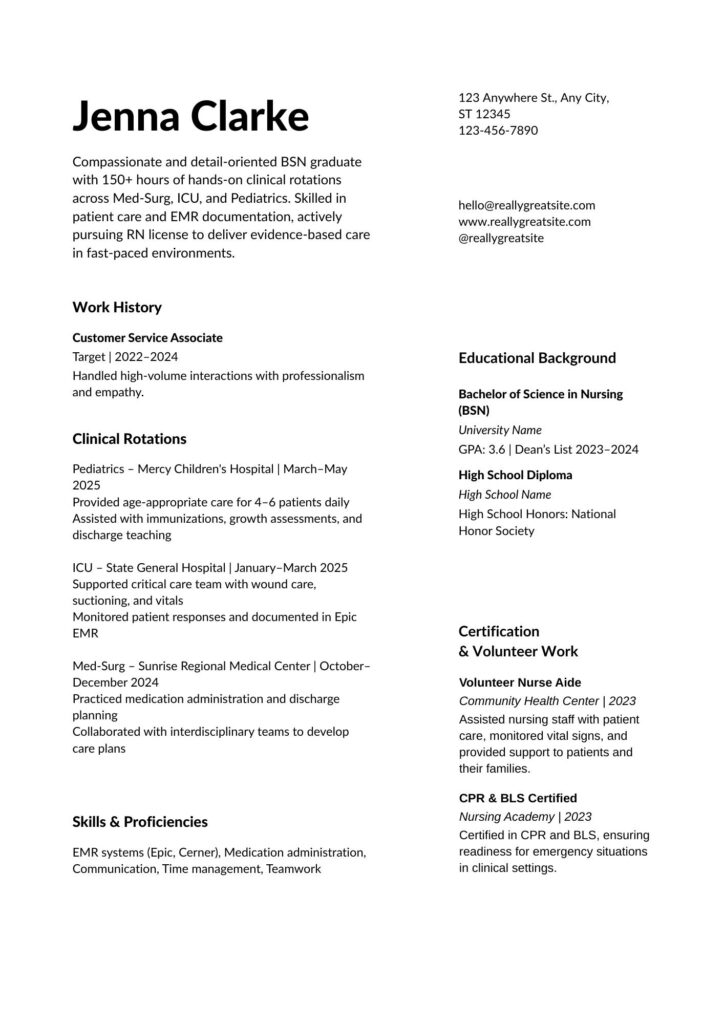By Sarah Johnson | Last updated April 2025

Table of Contents
You’ve worked hard to finish nursing school—but now comes the part no one warned you about: writing a resume when you have zero job experience. How are you supposed to compete with experienced nurses when your biggest asset is your clinical rotations?
Don’t worry—many successful nurses started exactly where you are.
In this guide, I’ll walk you through how to write a nursing graduate resume that highlights your hands-on training, communicates your potential, and gets past Applicant Tracking Systems (ATS)—even if this is your very first job application.
What Should a Nursing Graduate Resume Include?
When you’re building your first nursing graduate resume, every section should work together to highlight your readiness to care for patients. Even without job experience, your education and hands-on training already tell a story worth sharing.
Here’s what to include—and how to make each part count:
- Contact Information – Start with your full name, phone number, professional email, and city/state. You can also add your LinkedIn profile if it’s polished.
- Professional Summary or Objective – Write 2–3 sentences about who you are, your recent education, and what kind of nurse you aim to become. This is your elevator pitch, so tailor it to the role you’re applying for.
- Education and Certifications – List your nursing degree (BSN or ADN), school name, graduation date, and credentials like your RN license status—even if it’s pending. You can also mention GPA (if 3.5+), honors, or awards.
- Clinical Rotations – These are the heart of any entry-level nurse resume. Highlight the units you trained in, like Med-Surg, Pediatrics, or ICU. Include hospital names, rotation dates, and a short summary of skills or tasks performed.
- Relevant Experience – Even if it’s not in healthcare, jobs like retail, hospitality, or tutoring can show soft skills like teamwork, time management, or empathy. Frame these in a way that supports your nursing strengths.
- Nursing Skills – Section Include both hard and soft nursing skills to list on resume—like EMR systems, vital signs, communication, or patient education. Use bullet points for easy reading.
- Optional Sections – If space allows, add volunteer work, language skills, student nursing associations, or relevant projects. These help round out your profile.
Every item on your resume should reinforce your value as a new nurse. Think about what recruiters need to see to believe you’re ready to step onto the floor—even if it’s your first time doing so as an employee.
Resume Format and Layout Tips for New Nurses
The right layout can make the difference between getting noticed or getting skipped. As a new nurse, you want your nursing graduate resume to be clean, professional, and easy to scan—especially since many employers use Applicant Tracking Systems (ATS) to filter resumes before a human ever sees them.
To ensure your resume is ATS-friendly, use standard formatting, avoid fancy embellishments, and follow typical section titles.
Use a Clear, Professional Template
- Stick to a one-page resume unless you have extensive clinical experience or prior careers.
- Choose a modern, minimalist design with clear headings and bullet points.
- Avoid using images, tables, or fancy graphics—these can confuse ATS systems.
- Save your resume as a PDF unless the job description requests another format.
If you’re unsure where to start, using a free nursing resume template can take the guesswork out of formatting while keeping things clean and professional.
Choose the Right Resume Format
Your resume format should highlight your strengths and make your qualifications easy to find:
- Reverse-Chronological Format – The most common choice. Lists education and clinical experience in order from most recent to oldest. Ideal if you’ve completed recent clinicals or internships.
- Functional (Skills-Based) Format – Focuses more on skills and less on dates. This can work well if you have unrelated job history but strong clinical training.
- Combination Format – Blends both styles—great for those with some prior work experience or volunteer work relevant to nursing.
No matter the format, consistency is key. Make sure spacing, font sizes, and margins are uniform throughout your resume.
Which Resume Format Is Best for New Nurses?
| Format | What It Focuses On | Best For | Avoid If… |
|---|---|---|---|
| Reverse-Chronological | Your most recent education and clinical experience, listed top-down | Nursing graduates with strong clinical rotations or recent internships | You have large employment gaps or unrelated job history |
| Functional (Skills-Based) | Key nursing skills and abilities, not dates | Career changers or those with non-healthcare backgrounds | You lack concrete clinical examples or recent training |
| Combination (Hybrid) | Mix of skills and experience, showing both competencies and history | Graduates with some relevant work or volunteer experience | You’re unsure how to balance your story — can get cluttered if not formatted well |
Writing Your Nursing Resume Step-by-Step
Now that you know what to include and how to format it, let’s break down the actual writing process. Whether you’re working with a blank page or updating a draft, these five steps will help you create a strong nursing graduate resume that reflects your training, skills, and goals.
Step 1 – Start with a Strong Summary or Objective
The top of your resume is your chance to make a quick, confident first impression. Use 2–3 sentences to explain:
- Who you are (e.g., recent BSN graduate)
- What you’re passionate about (e.g., patient-centered care, pediatrics, ICU)
- A few standout clinical or soft skills
Example:
Compassionate BSN graduate with 150+ hours of ICU and Med-Surg clinical rotations. Dedicated to evidence-based care, strong team communication, and continued learning. Seeking an entry-level nurse resume position in a fast-paced hospital setting.
Step 2 – Highlight Your Education and Certifications
Your education is the foundation of your qualifications. Make sure it stands out.
Include:
- Full degree title (e.g., Bachelor of Science in Nursing)
- School name and location
- Graduation month and year
- Relevant honors, GPA (if 3.5+), and nursing coursework (optional)
- RN license status — even if it’s pending, write “NCLEX scheduled [Month, Year]” or “Passed NCLEX, awaiting license number”
Step 3 – Emphasize Your Clinical Rotations
If you’re writing a nursing resume with no experience, your clinical placements are your experience. Present them with intention.
List:
- Hospital name and department/unit
- Location and dates
- Bullet points with tasks, tools, and patient interactions
Example:
Pediatrics, Sunrise Medical Center — May–July 2024
- Completed 90 hours in pediatric unit with 3:1 patient ratio
- Assisted with medication administration and patient hygiene
- Documented in Epic EMR and observed developmental assessments
This is where new graduate nurse resume examples stand out—make it detailed enough to show what you actually did.
“When I review resumes for new graduate nurse roles, I’m not looking for years of experience—I’m looking for potential. A resume that clearly shows clinical exposure, soft skills, and attention to detail will always rise to the top.”— Alex Ramirez, RN Recruiter at Mercy Health
Step 4 – Add Relevant Work or Volunteer Experience
Even non-nursing jobs can work in your favor if framed correctly.
Focus on:
- Communication and teamwork
- Leadership or training roles
- Time-sensitive decision-making
- Compassionate service or client care
Example:
Retail Associate, Target – Part-Time (2022–2023)
- Supported high-volume customer service environment
- Resolved conflicts calmly and professionally
- Managed multitasking under pressure during holiday rushes
Step 5 – Tailor Your Skills Section
Use this section to list the top nursing skills to list on resume applications—both technical and interpersonal.
Hard skills:
- Vital signs
- EMR systems (e.g., Epic, Cerner)
- Wound care
- IV insertion
- Medication safety
Soft skills:
- Compassion
- Adaptability
- Communication
- Time management
- Teamwork
Scan job descriptions and mirror their language to pass ATS filters and speak directly to what hiring managers want.

6 Common Resume Mistakes New Nurses Make (and How to Fix Them)
Writing your first nursing graduate resume can feel overwhelming—but avoiding these common pitfalls can make a big difference in getting noticed. Here’s how to steer clear of the most frequent errors and what to do instead:
1. Sending the Same Resume to Every Job
Mistake: Using a one-size-fits-all resume that isn’t tailored to the specific role.
Fix it: Always tweak your resume to match the job posting. Update your summary, highlight the most relevant clinical rotations, and include the exact skills the employer is looking for.
2. Downplaying Your Clinical Experience
Mistake: Treating clinicals like an afterthought or leaving them vague.
Fix it: Think of your clinical rotations as real work experience. Name the units, explain what you did (like patient assessments or IV starts), and mention the tools or systems you used (like Epic EMR).
3. Including Non-Nursing Jobs Without Context
Mistake: Listing retail or food service jobs without showing relevance.
Fix it: These roles can still shine—just connect them to nursing skills. Did you multitask under pressure? Communicate with difficult customers? Lead a team? Say so.
4. Using Too Many Buzzwords
Mistake: Filling your resume with vague terms like “motivated” or “team player” without proof.
Fix it: Show, don’t just tell. Instead of saying you’re detail-oriented, mention that you accurately documented medication administration for five patients during a shift.
5. Skipping the Final Proofread
Mistake: Overlooking typos, awkward formatting, or mismatched fonts.
Fix it: Use a clean nursing resume template, read your resume out loud, and ask a mentor or friend to review it. Presentation matters—especially for healthcare roles where accuracy is critical.
6. Leaving Out Certifications or Licensure Info
Mistake: Forgetting to mention your RN license status or NCLEX progress.
Fix it: Even if you’re still waiting on your license, include this: “NCLEX passed, awaiting license” or “NCLEX scheduled for [Month, Year].” This shows employers you’re almost ready to start.
Avoiding these errors helps you stand out not just as a qualified applicant, but as someone who’s professional, detail-oriented, and ready to step into a clinical role.
Example Nursing Graduate Resume (Template)
Sometimes seeing a resume laid out properly is all it takes to connect the dots. Below is a simplified nursing graduate resume example that follows all the best practices we’ve covered.

Final Resume Checklist for New Nurses
Before you hit send, run through this quick checklist to make sure your nursing graduate resume is clear, professional, and tailored for success. A well-structured resume can be the difference between hearing nothing and landing that first interview.
✅ Is your resume one full page?
Keep it concise. Only extend to a second page if you have significant prior experience.
✅ Does it include your education, clinicals, and key skills?
These are the non-negotiables for a strong entry-level nurse resume.
✅ Have you customized it to match the job posting?
Use keywords from the listing—especially in your summary and nursing skills to list on resume.
✅ Is your formatting clean and consistent?
Check font size, spacing, bullet alignment, and margins. Use a trusted nursing resume template if needed.
✅ Did you proofread carefully (twice)?
Read it out loud or ask a friend to scan for errors, awkward phrasing, or missing info.
✅ Is your RN license status clear?
Note if your RN license is pending, scheduled, or active.
✅ Have you saved the file correctly?
Use a clear title like Firstname_Lastname_Resume.pdf and avoid strange characters or file types.
FAQs About Nursing Graduate Resumes
What should a new graduate nurse put on a resume?
Include your education, clinical rotations, certifications (like BLS/ACLS), a short professional summary, and both hard and soft nursing skills to list on resume. If you have no paid experience, emphasize your clinical work and transferable skills from other jobs.
How do you write a nursing resume with no experience?
Use your clinical training as the foundation. Highlight the departments you rotated through, the hands-on skills you practiced, and any tools or systems you used. Even without paid roles, a well-written nursing resume with no experience can still showcase your readiness.
Should I include my GPA on a nursing resume?
Yes, if your GPA is 3.5 or higher or if the job specifically requests it. Otherwise, it’s okay to leave it out and focus more on your RN license status and practical experience.
What are some good new graduate nurse resume examples?
Look for new graduate nurse resume examples that include real clinical tasks, customized skill sections, and clean formatting. Examples should show both competence and care—use real metrics or situations when possible.
How do I list clinical rotations on a resume?
List each rotation by specialty (e.g., Pediatrics, ICU), hospital name, dates, and a few bullet points describing your tasks. Mention things like patient load, procedures observed or performed, and systems used (e.g., Epic EMR).
Can I include non-nursing jobs on my resume?
Absolutely. Roles in customer service, retail, or food service can show soft skills like communication, adaptability, and reliability. Just frame them in a way that connects to your future role as a nurse.
How do I write a cover letter as a new graduate nurse?
Once your nursing graduate resume is ready, your cover letter is your next opportunity to stand out. It lets you express why you’re passionate about nursing and why you’re a great fit for the role.
Check out this complete guide to writing a graduate nurse cover letter for tips, structure, and examples.
Written by Sarah Johnson, RN
Career Development Consultant | 10+ years helping new nurses land their first roles
Sarah brings hands-on clinical experience and a background in resume coaching for nursing graduates.
Reviewed by Harleen Kaur, RN, MSN
Clinical Nurse Educator | NCLEX Mentor & Nursing School Lecturer
Harleen ensures all clinical advice meets current nursing standards and licensure expectations.

